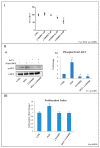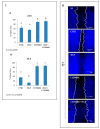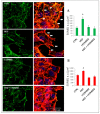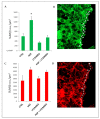The PI3K/AKT Pathway Is Activated by HGF in NT2D1 Non-Seminoma Cells and Has a Role in the Modulation of Their Malignant Behavior
- PMID: 33212946
- PMCID: PMC7698414
- DOI: 10.3390/ijms21228669
The PI3K/AKT Pathway Is Activated by HGF in NT2D1 Non-Seminoma Cells and Has a Role in the Modulation of Their Malignant Behavior
Abstract
Overactivation of the c-MET/HGF system is a feature of many cancers. We previously reported that type II testicular germ cell tumor (TGCT) cells express the c-MET receptor, forming non-seminomatous lesions that are more positive compared with seminomatous ones. Notably, we also demonstrated that NT2D1 non-seminomatous cells (derived from an embryonal carcinoma lesion) increase their proliferation, migration, and invasion in response to HGF. Herein, we report that HGF immunoreactivity is more evident in the microenvironment of embryonal carcinoma biopsies with respect to seminomatous ones, indicating a tumor-dependent modulation of the testicular niche. PI3K/AKT is one of the signaling pathways triggered by HGF through the c-MET activation cascade. Herein, we demonstrated that phospho-AKT increases in NT2D1 cells after HGF stimulation. Moreover, we found that this pathway is involved in HGF-dependent NT2D1 cell proliferation, migration, and invasion, since the co-administration of the PI3K inhibitor LY294002 together with HGF abrogates these responses. Notably, the inhibition of endogenous PI3K affects collective cell migration but does not influence proliferation or chemotactic activity. Surprisingly, LY294002 administered without the co-administration of HGF increases cell invasion at levels comparable to the HGF-administered samples. This paradoxical result highlights the role of the testicular microenvironment in the modulation of cellular responses and stimulates the study of the testicular secretome in cancer lesions.
Keywords: HGF; PI3K; PI3K inhibitors; TGCTs; c-MET; cancer therapy.
Conflict of interest statement
The authors declare no conflict of interest.
Figures









Comment in
-
Urological Oncology: Testis Cancer and Advances in Oncologic Therapy.J Urol. 2022 Mar;207(3):738-739. doi: 10.1097/JU.0000000000002374. Epub 2021 Dec 16. J Urol. 2022. PMID: 34911342 No abstract available.
Similar articles
-
ERK Signaling Pathway Is Constitutively Active in NT2D1 Non-Seminoma Cells and Its Inhibition Impairs Basal and HGF-Activated Cell Proliferation.Biomedicines. 2023 Jul 4;11(7):1894. doi: 10.3390/biomedicines11071894. Biomedicines. 2023. PMID: 37509533 Free PMC article.
-
c-Src Recruitment is Involved in c-MET-Mediated Malignant Behaviour of NT2D1 Non-Seminoma Cells.Int J Mol Sci. 2019 Jan 14;20(2):320. doi: 10.3390/ijms20020320. Int J Mol Sci. 2019. PMID: 30646583 Free PMC article.
-
Role of c-Met/phosphatidylinositol 3-kinase (PI3k)/Akt signaling in hepatocyte growth factor (HGF)-mediated lamellipodia formation, reactive oxygen species (ROS) generation, and motility of lung endothelial cells.J Biol Chem. 2014 May 9;289(19):13476-91. doi: 10.1074/jbc.M113.527556. Epub 2014 Mar 14. J Biol Chem. 2014. PMID: 24634221 Free PMC article.
-
MiR-206 inhibits HGF-induced epithelial-mesenchymal transition and angiogenesis in non-small cell lung cancer via c-Met /PI3k/Akt/mTOR pathway.Oncotarget. 2016 Apr 5;7(14):18247-61. doi: 10.18632/oncotarget.7570. Oncotarget. 2016. PMID: 26919096 Free PMC article.
-
Natural products and derivatives in renal, urothelial and testicular cancers: Targeting signaling pathways and therapeutic potential.Phytomedicine. 2024 May;127:155503. doi: 10.1016/j.phymed.2024.155503. Epub 2024 Feb 28. Phytomedicine. 2024. PMID: 38490077 Review.
Cited by
-
Case report: PIK3CA somatic mutation leading to Klippel Trenaunay Syndrome and multiple tumors.Front Genet. 2023 Aug 17;14:1213283. doi: 10.3389/fgene.2023.1213283. eCollection 2023. Front Genet. 2023. PMID: 37662840 Free PMC article.
-
ERK Signaling Pathway Is Constitutively Active in NT2D1 Non-Seminoma Cells and Its Inhibition Impairs Basal and HGF-Activated Cell Proliferation.Biomedicines. 2023 Jul 4;11(7):1894. doi: 10.3390/biomedicines11071894. Biomedicines. 2023. PMID: 37509533 Free PMC article.
-
Upregulated expression of miR-4443 and miR-4488 in drug resistant melanomas promotes migratory and invasive phenotypes through downregulation of intermediate filament nestin.J Exp Clin Cancer Res. 2023 Nov 27;42(1):317. doi: 10.1186/s13046-023-02878-9. J Exp Clin Cancer Res. 2023. PMID: 38008717 Free PMC article.
-
Oncofetal reprogramming in tumor development and progression: novel insights into cancer therapy.MedComm (2020). 2023 Dec 2;4(6):e427. doi: 10.1002/mco2.427. eCollection 2023 Dec. MedComm (2020). 2023. PMID: 38045829 Free PMC article. Review.
References
MeSH terms
Substances
Grants and funding
LinkOut - more resources
Full Text Sources
Medical
Molecular Biology Databases
Miscellaneous

